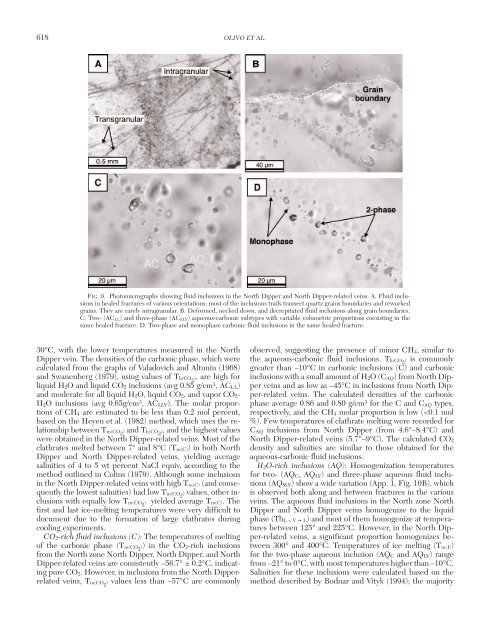Olivo, G.R., Chang, F., and Kyser, T.K., 2006. Formation of the ...
Olivo, G.R., Chang, F., and Kyser, T.K., 2006. Formation of the ...
Olivo, G.R., Chang, F., and Kyser, T.K., 2006. Formation of the ...
You also want an ePaper? Increase the reach of your titles
YUMPU automatically turns print PDFs into web optimized ePapers that Google loves.
618 OLIVO ET AL.<br />
FIG. 9. Photomicrographs showing fluid inclusions in <strong>the</strong> North Dipper <strong>and</strong> North Dipper-related veins. A. Fluid inclusions<br />
in healed fractures <strong>of</strong> various orientations; most <strong>of</strong> <strong>the</strong> inclusions trails transect quartz grains boundaries <strong>and</strong> reworked<br />
grains. They are rarely intragranular. B. Deformed, necked down, <strong>and</strong> decrepitated fluid inclusions along grain boundaries.<br />
C. Two- (AC LL) <strong>and</strong> three-phase (AC LLV) aqueous-carbonic subtypes with variable volumetric proportions coexisting in <strong>the</strong><br />
same healed fracture. D. Two-phase <strong>and</strong> monophase carbonic fluid inclusions in <strong>the</strong> same healed fracture.<br />
30°C, with <strong>the</strong> lower temperatures measured in <strong>the</strong> North<br />
Dipper vein. The densities <strong>of</strong> <strong>the</strong> carbonic phase, which were<br />
calculated from <strong>the</strong> graphs <strong>of</strong> Valadovich <strong>and</strong> Altunin (1968)<br />
<strong>and</strong> Swanenberg (1979), using values <strong>of</strong> T h(CO2 ), are high for<br />
liquid H 2 O <strong>and</strong> liquid CO 2 inclusions (avg 0.85 g/cm 3 , AC LL )<br />
<strong>and</strong> moderate for all liquid H 2 O, liquid CO 2 , <strong>and</strong> vapor CO 2 -<br />
H 2 O inclusions (avg 0.65g/cm 3 , AC LLV ). The molar proportions<br />
<strong>of</strong> CH 4 are estimated to be less than 0.2 mol percent,<br />
based on <strong>the</strong> Heyen et al. (1982) method, which uses <strong>the</strong> relationship<br />
between T m(CO2 ) <strong>and</strong> T h(CO2 ), <strong>and</strong> <strong>the</strong> highest values<br />
were obtained in <strong>the</strong> North Dipper-related veins. Most <strong>of</strong> <strong>the</strong><br />
clathrates melted between 7° <strong>and</strong> 8°C (T m(C) ) in both North<br />
Dipper <strong>and</strong> North Dipper-related veins, yielding average<br />
salinities <strong>of</strong> 4 to 5 wt percent NaCl equiv, according to <strong>the</strong><br />
method outlined in Colins (1979). Although some inclusions<br />
in <strong>the</strong> North Dipper-related veins with high T m(C) (<strong>and</strong> consequently<br />
<strong>the</strong> lowest salinities) had low T m(CO2 ) values, o<strong>the</strong>r inclusions<br />
with equally low T m(CO2 ) yielded average T m(C) . The<br />
first <strong>and</strong> last ice-melting temperatures were very difficult to<br />
document due to <strong>the</strong> formation <strong>of</strong> large clathrates during<br />
cooling experiments.<br />
CO 2 -rich fluid inclusions (C): The temperatures <strong>of</strong> melting<br />
<strong>of</strong> <strong>the</strong> carbonic phase (T m(CO2 )) in <strong>the</strong> CO 2 -rich inclusions<br />
from <strong>the</strong> North zone North Dipper, North Dipper, <strong>and</strong> North<br />
Dipper-related veins are consistently –56.7° ± 0.2°C, indicating<br />
pure CO 2 . However, in inclusions from <strong>the</strong> North Dipperrelated<br />
veins, T m(CO2 ) values less than –57°C are commonly<br />
observed, suggesting <strong>the</strong> presence <strong>of</strong> minor CH 4 , similar to<br />
<strong>the</strong> aqueous-carbonic fluid inclusions. T h(CO2 ) is commonly<br />
greater than –10°C in carbonic inclusions (C) <strong>and</strong> carbonic<br />
inclusions with a small amount <strong>of</strong> H 2 O (C AQ ) from North Dipper<br />
veins <strong>and</strong> as low as –45°C in inclusions from North Dipper-related<br />
veins. The calculated densities <strong>of</strong> <strong>the</strong> carbonic<br />
phase average 0.86 <strong>and</strong> 0.80 g/cm 3 for <strong>the</strong> C <strong>and</strong> C AQ types,<br />
respectively, <strong>and</strong> <strong>the</strong> CH 4 molar proportion is low (

















